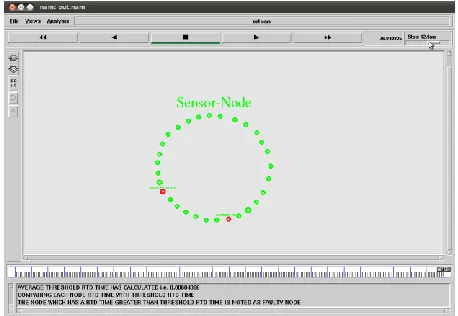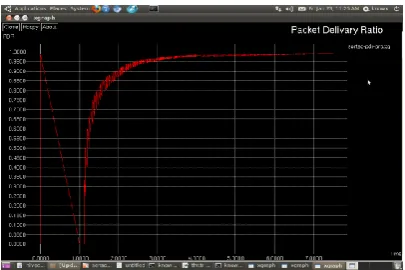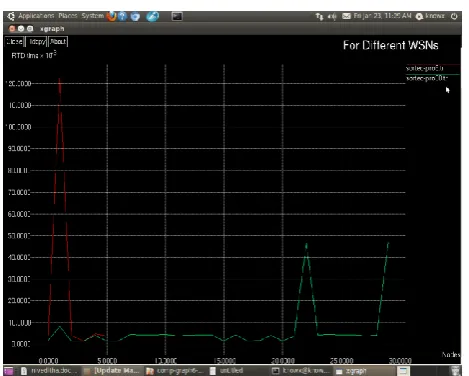© 2015, IRJET.NET- All Rights Reserved
Page 95
Failure detection of sensor nodes based on Round Trip Delay
and Paths in Wireless Sensor Networks
Nevidhitha Bonnita. P, Dr.Nalini.N, Mohan.B.A
1
MTech Student, Dept of computer science (PG), NMIT, Karnataka, India
2
Principal
, Shridevi Institute of Engineering and Technology, Tumkur, Karnataka, India
3
Asst Prof,
Dept of Computer Science (UG), NMIT, Karnataka, India
---***---Abstract -
In recent years, the applications of the wirelesssensors networks (WSN) have increased tremendously due to its huge potential of connecting the physical world and the virtual world. Also, advancement in Microelectronic Fabrication Technology (MFT) decreases the cost of manufacturing portable wireless sensor nodes. It is a trend to deploy large number of wireless portable sensors in the WSNs to have an increased quality of service (QoS). The QoS of WSNs is hugely affected by the failure of the sensor nodes. The portability of failures in sensor nodes is directly proportional to increase in the number of sensors. In order to keep up better QoS under failure conditions, identifying and removing such faults are important.
In the proposed method, the faulty sensor nodes are signal strength measurement in the cluster head variation and assigning separate wavelength of each of the link in other fault detection techniques are overcome in this method.
Key Words:
Sensor nodes, RTD (round trip delay), RTP
(round trip path), RTDT (round trip dealy time),
threshold, faulty, malfunctioning, packets, circular
topology, QoS (quality of service, transmission, discrete
RTP.
1. INTRODUCTION
Wireless Sensor Network (WSN) is a wireless network, which consists of hundreds and hundreds of
sensor nodes that are deployed in any area to monitor the status of military applications, weather, forest surveillance etc. there is a huge advantage of using sensor nodes in many applications, we also find some disadvantages since, the sensor nodes are small in size and contains non-rechargeable batteries. This leads to battery constraint and reduces the lifetime of the network
Round trip delay (RTD) time measurement technique is an easy way to obtain the information regarding above issues in WSN. The method of fault detection is based on RTD time measurement of RTPs. RTD times of discrete RTPs are compared with threshold time to determine failed sensor node. Initially this method is tested on 6,30 sensor nodes Round-trip delay (RTD), also called as round-trip time (RTT), is the time required for a signal pulse or packet to travel from a specific source node thru path consisting other nodes and back again. The round trip delay time can range from a few milliseconds (thousandths of a second) under ideal conditions between nearby spaced sensor nodes to several seconds under adverse conditions between sensor nodes separated by a large distance.
Round trip delay time of the RTP will be change due to the faulty sensor node. Higher than the threshold value that we got. Faulty sensor node is detected by the RTD time of RTPs with threshold value [13]. The sensor node more than threshold value is detected has the failure sensor node. If this time is higher than the threshold value then this senor node is detected as faulty node. Detection time of faulty sensor node depends upon the numbers of RTPs and RTD time.
© 2015, IRJET.NET- All Rights Reserved
Page 96
during fault detection this will improve the lifetime as wellas quality of service (QoS) of WSNs. Software tool NS2 is used to implement RTDT protocol. Faulty sensor node is detected by simulating circular topology WSNs with RTDT protocol.
In a network RTD time is affected by many criteria’s. One of them is latency, which is the time between a request for data and the complete return of the data. The round trip delay (RTD) time depends on various factors including:
a) Sensor node Data transfer rate b) Nature of transmission medium.
c) The Physical distance between the sensor nodes. d) The Number of nodes in the RTD path.
e) Other requests being handled by intermediate nodes. f) Intermediate nodes and source node functions speed g) Interference in the circuit.
2. Related work
The faulty sensor nodes identification suggested in [1] is based on comparisons between neighboring nodes and dissemination of the decision made at each node. Algorithm proposed in this method can’t detect the malicious nodes. Cluster head failure recovery algorithm used in [2] to detect the faulty node has data loss problem, occurring due to transfer of cluster head. Path redundancy technique to detect faulty sensor node is suggested in [3] and [4]. The exercise to use large numbers of sensor nodes will increases the probability of sensor node failures in responses in network lifetime. Excessive redundant paths in WSNs will slow down the fault detection process. Better quality of service (QoS) is achieved by discarding the data from such faulty sensor nodes in the analysis [6], [7]. Excessive redundant paths in WSNs will slow down the fault detection process. In [14], link failure detection based on monitoring cycles (MCs) and monitoring paths (MPs) is presented. Three-edge connectivity in the network, separate wavelength for each monitoring cycle and monitoring locations are the limitations of this method.
3. Software analysis
Circular topology WSNs having different sensor nodes (N) are implemented by using the open source software NS2.
In the proposed method round trip paths are formed by combining the adjacent three sensor nodes. RTDT protocol
is developed and implemented to measure the RTDT time of such RTPs.
3.1 Proposed Protocol implementation
In this protocol a RTP is formed between the three sequential sensor nodes in circular topology of WSNs. A packet is routed in between these sensor nodes of RTP. It is routed in the round trip delay path by assigning the addresses of source, Forwarding and destination senor nodes in routing table. The circular topology of WSNs with six and thirty sensor nodes(N = 6,30) implemented and
© 2015, IRJET.NET- All Rights Reserved
Page 97
Step2: The Sensor nodes will move to their particular
position to form a circular Topology.
Step3: Find RTP, i.e.
Pd = Q+C
Q = [N/M]
C = 0 if R = 0,
1 otherwise
Step4: Transmission starts between three sensor nodes,
Step5: Step4 continues until all the sensor nodes should
be involved in the transmission. Then go to next step.
Step6: Find RTD of all the sensor nodes.
Step7: Find Threshold Value.
Step8:Compare each sensor node RTD with Threshold
value, and then the nodes having RTD greater than
Threshold Value means that node is consider as Faulty
sensor node.
Step9: Performance graphs are found to show the Faulty
sensor nodes.
© 2015, IRJET.NET- All Rights Reserved
Page 98
Flow Chart
4.
Detection of Faulty Sensor Node Using Discrete
RTPs
Specific sensor node in WSNs is declared as faulty in order to test and verify the suggested method. Faulty sensor node can be either failed or malfunctioning as shown in fig 3 and fig 4 hence two cases have to be evaluated separately. Failed (dead) sensor node Detection is done by declaring the particular node as dead in Tcl script. Similarly malfunctioning behavior is detected by adding certain delay in the RTPs of particular sensor node. To test the malfunctioning behavior of sensor node respectively.
4.1RTD and Threshold Time Estimation
Appropriate threshold RTD time is determined by simulating various WSNs. It is estimated by considering initially all sensor nodes in WSNs as working properly. The Tcl file with different numbers of sensor nodes as 6, 30 are simulated separately by using RTDT protocol. RTD time results of discrete RTPs simulated in NS2 for WSNs with senor nodes 6, 30, are shown in Fig. Here we have found that the average time span for round trip delay time and the highest value of RTD time Hence the Threshold value of RTD time for RTP is selected.
Figure 3: Screen Shot of Detection of Faulty Sensor Node Using Discrete RTPs for 6 nodes
Figure 4: Screenshot of Detection of Faulty Sensor Node Using Discrete RTPs for 30 nodes
5. RESULT ANALYSIS
Method described to detect the fault is successfully tested
in software. Due to complexity in hardware
© 2015, IRJET.NET- All Rights Reserved
Page 99
implemented and tested in NS2 software. Packet deliveryratio, throughput and the comparisons graphs are shown in fig 5, 6, and 7 (for 6 nodes) and fig 8, 9 and 10 (for 30 nodes)
Figure 5: Packet delivery ratio for 6 node sensor nodes.
Figure 6: Throughput for 6 Sensor Nodes.
Figure 7: RTD time simulation results for different WSNs. RTD time results of discrete RTPs for faulty node S1 in WSNs
with N = 6.
Figure 8: Packet delivery ratio for 30 node sensor nodes.
Figure 9: Throughput for 30 Sensor Nodes
Figure10: RTD time simulation results for different WSNs time results of discrete RTPs for faulty node S22 and S29 in
© 2015, IRJET.NET- All Rights Reserved
Page 100
Figure 11: RTD time simulation results for different WSN’s i.e. for 6 and 30 Sensor Nodes.
Analysis time to detect fault is very much optimized by using the discrete RTPs. Simulation results obtained in WSNs with large numbers of sensor nodes are sufficient to prove the scalability of investigated method. Also it validates the real time applicability of the method and it is shown in fig 11.RTD time results obtained in software are to be compared to prove the real time applicability of investigated method. As various time delays are associated in hardware and software implementation of proposed method. These delays have to be deducted from actual measurement, to obtain the exact RTD time in hardware and software
6. Conclusion and Future Enhancement
In future work, we are implementing and testing the performance of suggested methods with different topologies of WSNs like triangular and rectangular. This will be useful to validate the complexity and applicability of investigated method to various types of WSNs.
References
[1] B M. Lee and Y. Choi, “Fault detection of wireless sensor networks,”Comput. Commun., vol. 31, pp. 3469–3475, Jun. 2008.
[2] A. Akbari, A. Dana, A. Khademzadeh, and N. Beikmahdavi, “Faultdetection and recovery in wireless sensor network using clustering,”IJWMNvol. 3, no. 1, pp. 130–138, Feb. 2011.
[3]C.-C. Song, C.-F.Feng, C.-H.Wang, and D.-C.Liaw, “Simulationand experimental analysis of aZigBee sensor network with faultdetection and reconfiguration mechanism,” in
Proc. 8th ASCC, May2011, pp. 659–664.
[4]A. Mojoodi, M. Mehrani, F. Forootan, and R.Farshidi, “Redundancyeffect on fault tolerance in wireless sensor networks,” Global J. Comput.Sci. Technol., vol. 11, no. 6, pp. 35-40, Apr. 2011.
[5] I. Chen, A. P. Speer, and M. Eltoweissy, “Adaptive fault tolerant QoS control algorithms for maximizing system lifetime of query-based wireless sensor networks,” IEEE Trans. Dependable Secure Comput., vol. 8, no. 2, pp. 1–35, Mar./Apr. 2011.
[6] A. A. Boudhir, B. Mohamed, and B. A. Mohamed, “New technique of wireless sensor networks localization based on energy consumption,” Int. J. Comput. Appl., vol. 9, no. 12, pp. 25– 28, Nov. 2010.
[7] W. Y. Poe and J. B. Schmitt, “Node deployment in large wireless sensor networks: Coverage, energy consumption, and worst-case delay,” in Proc. ACM, AINTEC, Nov. 2009, pp. 1–8.
[8]Reffered by Marc Gries tutorials for NS2 basics and simulations. Adaptive Fault-Tolerant QoS Control Algorithms for Maximizing System Lifetime of Query-Based
[9]“Adaptive Fault-Tolerant QoS Control Algorithms for Maximizing System Lifetime of Query-Based Wireless Sensor Networks” -Ing-Ray ChenDept. of''Computer. Sci., Virginia Tech
[10]“Efficient Fault Node Detection in WSN using RTD Calculation”S.Mathumitha ,S. Kavipriya , T.RevathiPG Scholar.
[11]“Round trip delay time as a linear function of distance between the sensor nodes in wireless sensor network” - Ravindra N Duche, N.P.Sarwade
[12] “Implementation of WSNs in Patient Monitoring With Sensor Node Failure Detection” - S. Gajalakshmi, P. Preethi, T. Saranya, JebasinghKirubakaran. S. J
[13]“Faulty Sensor Node Detection Using Round TripTime and Discrete Paths in WSNs” - Ravindra N Duche, N.P.Sarwade.
© 2015, IRJET.NET- All Rights Reserved
Page 101
BIOGRAPHIES
Nevidhitha Bonnita. P pursing
MTech final year in Nitte
Meenakshi institute of technology Bangalore. My area of research is in wireless sensor networks.
Nalini. N is currently working as Principal at Shridevi Institute of
Engineering and Technology,
Tumkur. Her research interests are
Cryptography and Network
Security, Wireless Sensor
Networks, Security issues in Cloud Environment. She has more than 20 International Journal papers Conference publications to her credit. She has received “Bharath Jyothi Award “by Dr.Bhishma Narain Singh, Former Governor of Tamilnadu and Assam, given by India International Friendship Society on 20-DEC-2012
Mohan B A Asst. Prof. Dept. of CS&E, NMIT, Bangalore has 8 years of Teaching experience in NMIT
and 2 years of Research
Experience. completed BE in BMS Evening College in the year 2005 and Mtech in SJCE Mysore in 2007.area of interest is routing in
wireless sensor networks,
registered for Phd in VTU, Belgaum. Other Qualifications are
Novell certified System
Administrator and data centre technician.


